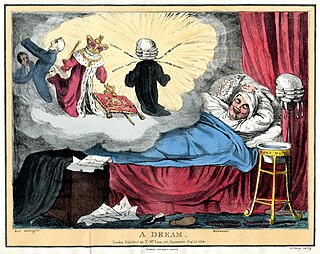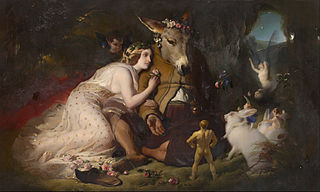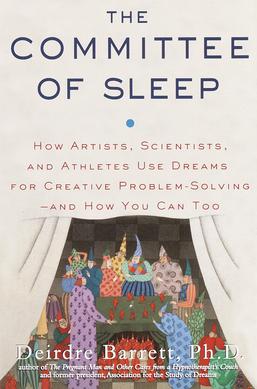
A dream is a succession of images, ideas, emotions, and sensations that usually occur involuntarily in the mind during certain stages of sleep. Humans spend about two hours dreaming per night, and each dream lasts around 5 to 20 minutes, although the dreamer may perceive the dream as being much longer than this.

Creativity is a characteristic of someone that forms something novel and valuable. The created item may be intangible or a physical object. Creativity enables people to solve problems in new or innovative ways.
Creative problem-solving (CPS) is the mental process of searching for an original and previously unknown solution to a problem. To qualify, the solution must be novel and reached independently. The creative problem-solving process was originally developed by Alex Osborn and Sid Parnes. Creative problem solving (CPS) is a way of using creativity to develop new ideas and solutions to problems. The process is based on separating divergent and convergent thinking styles, so that one can focus their mind on creating at the first stage, and then evaluating at the second stage.
Hypnagogia is the transitional state from wakefulness to sleep, also defined as the waning state of consciousness during the onset of sleep. Its opposite state is described as hypnopompia – the transitional state from sleep into wakefulness. Mental phenomena that may occur during this "threshold consciousness" phase include hypnagogic hallucinations, lucid dreaming, and sleep paralysis.
Creativity techniques are methods that encourage creative actions, whether in the arts or sciences. They focus on a variety of aspects of creativity, including techniques for idea generation and divergent thinking, methods of re-framing problems, changes in the affective environment and so on. They can be used as part of problem solving, artistic expression, or therapy.
Insight is the understanding of a specific cause and effect within a particular context. The term insight can have several related meanings:

Problem solving is the process of achieving a goal by overcoming obstacles, a frequent part of most activities. Problems in need of solutions range from simple personal tasks to complex issues in business and technical fields. The former is an example of simple problem solving (SPS) addressing one issue, whereas the latter is complex problem solving (CPS) with multiple interrelated obstacles. Another classification of problem-solving tasks is into well-defined problems with specific obstacles and goals, and ill-defined problems in which the current situation is troublesome but it is not clear what kind of resolution to aim for. Similarly, one may distinguish formal or fact-based problems requiring psychometric intelligence, versus socio-emotional problems which depend on the changeable emotions of individuals or groups, such as tactful behavior, fashion, or gift choices.
Dream incubation is a thought technique which aims for a specific dream topic to occur, either for recreation or to attempt to solve a problem. For example, a person might go to bed repeating to themselves that they will dream about a presentation they have coming up, or a vacation they recently took. While somewhat similar to lucid dreaming, dream incubation is simply focusing attention on a specific issue when going to sleep.
Insight is a sudden understanding of a problem or a strategy that aids in solving a problem. Usually, this involves conceptualizing the problem in a completely new way. Although insights may appear to be sudden, they are actually the result of prior thought and effort. While insight can be involved in solving well-structured problems, it is more often associated with ill-structured problems.

The following outline is provided as an overview of and topical guide to thought (thinking):

Divergent thinking is a thought process used to generate creative ideas by exploring many possible solutions. It typically occurs in a spontaneous, free-flowing, "non-linear" manner, such that many ideas are generated in an emergent cognitive fashion. Many possible solutions are explored in a short amount of time, and unexpected connections are drawn. Following divergent thinking, ideas and information are organized and structured using convergent thinking, which follows a particular set of logical steps to arrive at one solution, which in some cases is a "correct" solution.

The majority of studies on sleep creativity have shown that sleep can facilitate insightful behavior and flexible reasoning, and there are several hypotheses about the creative function of dreams. On the other hand, a few recent studies have supported a theory of creative insomnia, in which creativity is significantly correlated with sleep disturbance.

The eureka effect refers to the common human experience of suddenly understanding a previously incomprehensible problem or concept. Some research describes the Aha! effect as a memory advantage, but conflicting results exist as to where exactly it occurs in the brain, and it is difficult to predict under what circumstances one can predict an Aha! moment.
Convergent thinking is a term coined by Joy Paul Guilford as the opposite of divergent thinking. It generally means the ability to give the "correct" answer to questions that do not require novel ideas, for instance on standardized multiple-choice tests for intelligence.
Deirdre Barrett is an American author and psychologist known for her research on dreams, hypnosis and imagery, and has written on evolutionary psychology. Barrett is a teacher at Harvard Medical School, and a past president of the International Association for the Study of Dreams (IASD) and of the American Psychological Association’s Div. 30, the Society for Psychological Hypnosis. She is editor-in-chief of the journal Dreaming: The Journal of the Association for the Study of Dreams and a consulting editor for Imagination, Cognition, and Personality and The International Journal for Clinical and Experimental Hypnosis.
The Remote Associates Test (RAT) is a creativity test used to determine a human's creative potential. The test typically lasts forty minutes and consists of thirty to forty questions each of which consists of three common stimulus words that appear to be unrelated. The subject must think of a fourth word that is somehow related to each of the first three words. Scores are calculated based on the number of correct questions.
Marino (Min) Sidney Basadur is a teacher, consultant and researcher best known for his work in applied creativity and as the developer Simplexity Thinking System for improving workplace innovation & creativity. He is president of Basadur Applied Creativity and professor emeritus of organizational behavior and innovation at McMaster University's Michael G. DeGroote School of Business.
The neurocircuitry that underlies executive function processes and emotional and motivational processes are known to be distinct in the brain. However, there are brain regions that show overlap in function between the two cognitive systems. Brain regions that exist in both systems are interesting mainly for studies on how one system affects the other. Examples of such cross-modal functions are emotional regulation strategies such as emotional suppression and emotional reappraisal, the effect of mood on cognitive tasks, and the effect of emotional stimulation of cognitive tasks.

The Committee of Sleep: How Artists, Scientists, and Athletes Use Dreams for Creative Problem-Solving—and How You Can Too is a book by Deirdre Barrett published by Crown/Random House in 2001. Barrett is a psychologist on the faculty of Harvard Medical School. The book describes how dreams have contributed practical breakthroughs to arts and sciences in the waking world. Chapters are organized by discipline: art, literature, science, sports, medicine, etc. There are long examples of dreams which led to major achievements in each area, but Barrett then draws conclusions about how dreams go about solving problems, what types they are best at, and gives advice on how readers can apply these techniques to their own endeavors. Those who are described in The Committee of Sleep as having dreamed creations include Ludwig van Beethoven, Billy Joel, Robert Louis Stevenson, Stephen King, Salvador Dalí, William Blake, and Nobel prize winner Otto Loewi.

Denise Cai is an Assistant Professor of Neuroscience at the Icahn School of Medicine at Mount Sinai.